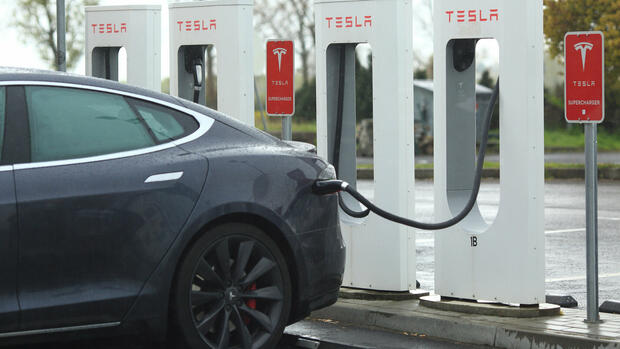New York, Dusseldorf The announcements follow in quick succession. On Tuesday, the Swedish car manufacturer Volvo announced that it would have access to Tesla’s charging network in America, the so-called supercharger stations.
As a result of the agreement between the two car manufacturers, Volvo drivers will be able to use around 12,000 Tesla charging stations in the USA, Canada and Mexico from next year. Volvo is also the first European car manufacturer to adopt Tesla’s North American charging standard (NACS).
For Tesla boss Elon Musk, the run on his supercharger network is a success. Tesla, which recently struggled with weakening sales figures, can use the additional income.
In North America, the Group has developed a unique position in the charging market as an electric pioneer. According to the US Department of Energy, Tesla’s superchargers account for around 60 percent of all US fast charging stations.
“On our way to becoming fully electric by 2030, we want to make living with an electric car as easy as possible,” said Volvo Cars boss Jim Rowan. “Access to a simple and convenient charging infrastructure” is a “main obstacle” when switching to e-mobility. Thanks to Tesla, this hurdle is now being removed in North America.
praise from experts
Market observers see Tesla strengthened by the announcements. “The surveys clearly show that for potential buyers of electric vehicles, in addition to the ‘fear of range’, the ‘fear of charging’ is the biggest obstacle to buying,” explains Christian Koenig. The car expert has worked for Porsche in North America and runs an electromobility consultancy in Atlanta.
A study by the analysis company JD Power shows that one in five Americans was recently unable to charge their vehicle due to technical defects at public charging stations. According to Koenig, this shows the challenge that Ford, GM, Rivian and now Volvo have recognized. “That’s why they rely on Tesla and by far the best charging network in the industry.” This sets standards in terms of speed, efficiency and safety.
According to Koenig, this will become a problem for the car manufacturers that are not part of the alliance. “You can’t currently rely on many charging providers such as Electrify America.” Here, charging cables are often broken, payment does not work, stations cannot be found or the charging speed is significantly slower than stated.
challenge for the competition
Electrify America was built by VW starting in 2017. In the course of the diesel scandal, VW was obliged to invest two billion dollars. Today, Electrify America operates 3,500 charging stations, around a quarter as many as Tesla.
With the rise of the Supercharger network, VW customers are at risk of falling behind. Is a separate cooperation between VW and Tesla conceivable? “We listen to our customers and continue to evaluate the market, including this development,” explains Electrify America when asked by Handelsblatt with reference to the new Tesla partnerships. According to industry circles, corresponding considerations are already being played out.
>> Read also: ID.4 is now being promoted by the IRA in the USA
Mercedes-Benz also has to ask itself how it intends to make attractive charging offers for electric car customers in the USA in the future. “The course at Mercedes-Benz has been set for a fully electric future,” explains a spokeswoman on request. Mercedes-Benz plans to set up more than 10,000 of its own charging stations in North America, Europe, China and other core markets by the end of the decade. These “will be accessible to electric vehicles of all brands.”
In North America, Mercedes-Benz relies on its partner Chargepoint. The group does not want to comment on possible considerations regarding new partnerships, such as with Tesla.
According to industry observers, independent charging platforms such as EVgo or Chargepoint are now also under pressure. Their shares plummeted after the Tesla announcements.
North American charging standard on the rise
It is clear that with the triumph of the supercharger network, the Tesla charging standard NACS will also become more and more established. The competing CCS standard is falling behind in North America. The latter was developed more than a decade ago, primarily by German car manufacturers.
Mercedes explains that they rely “on standardized charging standards to enable a first-class charging experience”. “We deal with the global developments in charging technology. We check and evaluate the technical implementation of the NACS and the resulting customer benefits.”
The situation in Europe is different. Tesla’s superchargers are widely available here, and individual stations are already open to competitor cars. The charging standard here is CCS, which is also related to the power grid in Europe. All V3 named Tesla Superchargers in Europe feature CCS single cable technology compatible with any Model 3, Model Y and Model S or Model X produced from May 2019.
>> Read also: “My autopilot almost killed me”: Tesla files cast doubt on Elon Musk’s promises
In the USA, the charging network is likely to be significantly expanded in the coming years. Tailwind comes from Washington: The US government is funding the expansion of charging stations with 7.5 billion dollars.
In the future, the new partnerships will mean that more and more drivers will rely on Tesla’s charging service. However, Tesla is also facing an important challenge, according to car expert Koenig: “The big question is, can Tesla continue to ensure a premium charging experience if its network will soon also be used by GM, Ford, Rivian and Volvo customers?”
According to Koenig, Musk urgently needs to prevent queues in front of the superchargers by expanding the network and using intelligent software. Otherwise, loyal Tesla customers risk being deterred.
More: Loud, leaking and bad braking behavior? Tesla files raise doubts about the Cybertruck
